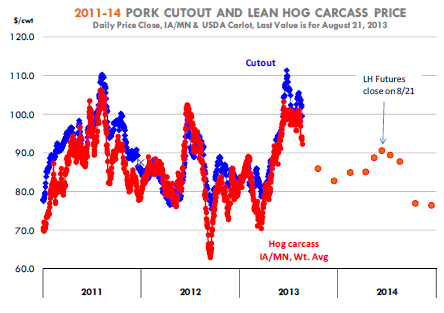



CME: Are Producers Trying to Pull Marketings Forward?
US - Nearby hog futures declined $1.125 and overnight futures were down another 45 cents, write Steve Meyer and Len Steiner.The October contract has declined by almost 300 points in the last 10 days as market participants have been unnerved by the sharp pullback in hog cutout values. Particularly concerning has been the decline in the value pork trimmings, a reminder that the end of summer demand is near. Last night, 72CL pork trim was quoted at $63.39/ cwt, down about 22 per cent from a week ago and 37 per cent lower than where it was in early August.
While pork trim prices normally decline in late August and September, the sharp decline caught many by surprise and was likely seen as an indication that some of the retail demand underpinning pork values so far may start to shift to other items. Hog carcass weights also have been increasing recently, which has added to the pounds of trim available in the market.
The overall pork cutout closed last night at $99.57/cwt, down about $3.57/cwt from a week ago and down about $11.76/cwt (-11 per cent) from the annual high on 26 June. While the pork cutout decline may have been anticipated given the lofty levels the market hit in late June, the rapid decline in cash hog values has been troubling. Producers appear anxious to push hogs to market, in part to limit the carcass gains due to the cooler than expected weather in some areas. Also they are trying to take advantage of the still relatively high prices available before the market seasonally declines in the fall.


Spot feed costs remain particularly high and adding additional pounds to hogs does not seem to make much sense at this point. Last night the Iowa/MN hog carcass price was quoted at $92.30/cwt, down almost $6 from a week ago. The number of hogs coming to market has been somewhat surprising, especially when considering that last year we saw a sharp rise in the number of hogs traded at about this time. The expectation was that compared to a year ago hog slaughter numbers would show a notable decline but that has not been the case.
In the first three days of this week daily hog slaughter has averaged about 429,000 head, compared to an average of 422,000 head a week ago and 425,000 head last year. The big gains last year were in the Saturday slaughter numbers as packers ran extra shifts to accommodate the pickup in marketings.
Last week the Saturday slaughter was around 70,000 head, a fairly large number. Some estimates are for about the same or even higher number coming to market this week. If that is the case, we could see hog slaughter for the week at a little over 2.2 million head, a big number for a week in August. Despite the strong demand, the extra supply certainly has put pressure on prices, especially trimmings.
Are producers doing the same thing they did last year, trying to pull marketings forward? We should be able to see this in the hog carcass weight levels. Based on the MPR numbers, we calculate that hog carcass weights are currently hovering at around 204 pounds per carcass. The weights were on an uptrend since late July and early August but appear to have slowed down in recent days (remember the line in the chart above is a 7-day moving average).
If that is the case, the early marketings now could offer dividends down the road. One positive, in our view, is that the ham market continues to be quite strong, which will be necessary to carry carcass values into the fall. We should get some indication on ham stocks today when USDA releases its monthly cold storage report. Belly prices have slowed down, as they normally do at this time but they remain a wild card, especially if hog numbers pull back in October and November.








